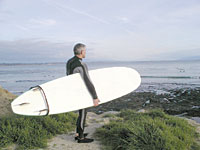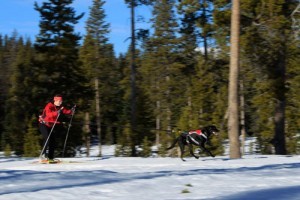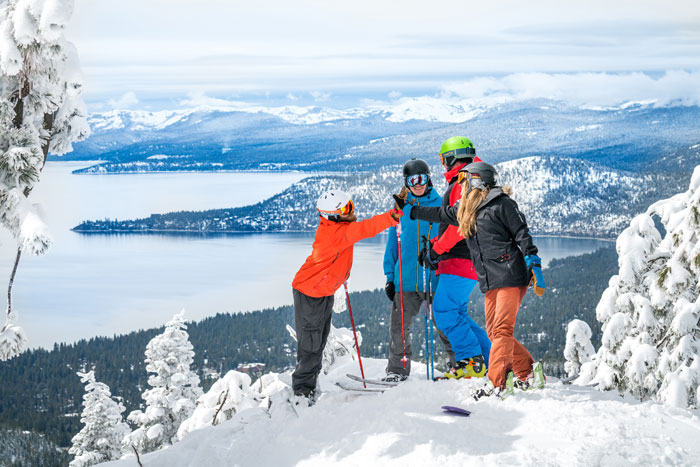- Tahoe’s Nevada Beach Tops the List of Hard-to-Book Campgrounds - 07/17/2024
- Cannabis Watershed Protection Program Cleans Up Illegal Grow Sites - 07/10/2024
- French Fire - 07/05/2024
It’s springtime. There is still snow on the mountain passes, but some of it has started to melt. Rivers are beginning to run, creating ideal playground flows for boaters. And the winds that surge in with March and April are arriving in gusts, churning up waves. Conditions are perfect for playing outside.
Everyone has a new sport on their adventure list that they have been meaning to try for years — this is the year to do it. Simultaneously inspiring, hilarious, and painful, starting a new sport is not easy, but it is worth it. In the next six pages, we follow six rookies as they make their first attempts at new sports.
Vicariously, we get to try snowboarding, kitesurfing, telemark skiing, ocean kayaking, surfing and outdoor climbing through the eyes of these beginners. We won’t share their bumps and bruises with them, but we will share
their enthusiasm and maybe get inspired to try something new on our list. After all, it’s springtime — a perfect time for starting something new.
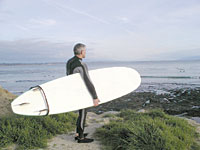
Photo: Elliot Kay
SURFING: Old Man and the Sea
By Jerry Kay
I’m 58 years old and I’m going to learn how to surf. I’ve done just about everything else in the ocean for the past 20 years: I’ve bodysurfed and body-boarded. I’ve scuba-dived and snorkeled in several oceans.
So why this late inclination to surf? Three reasons: It’ll save me from golf, which has claimed the minds and bodies of some of my best friends.It’ll give me another reason to go into the water now that my usual body-boarding buddies are chained to land by work and families.Mostly, I want to learn because, after 20 years of lying prone in the ocean, I want to evolve. I want to stand up on my feet and see how it feels.
While body boarding, I would tell myself, “I like riding a wave lying down; it puts me into the wave, right on top of the wave, like… like… making love to it.”But my romantic notions of belly surfing have faded because I no longer want surfers to refer to me as a ‘speed bump.’
Am I hoping to imitate one of those lean kids on a pointy short board, shredding back and forth down the steep face of a 10-foot breaker?Nah, I’m only hoping to dance a longboard with some grace diagonally down the slope of some mild waves. I have harbored this secret desire to surf upright for years but never admitted it.
So, I take myself one fine, foggy summer day to Cowell’s Beach and rent a surfboard—a huge monster—and give it a try. After fin-kicking around for so many years on a sponge body board, paddling a surfboard feels like propelling a redwood log with your arms.And in a wetsuit it’s hard trying to aim toward shore, screw your neck around and see a wave coming.After 45 minutes, my arms are rubbery, my neck is kinked and I haven’t caught one wave.
I need a lesson.But it isn’t until I take the family to Hawaii during the following spring break that I’m able to take a warm-water lesson with my 13-year-old son.I learn a few things on this easy, balmy Lahaina
break.Like, how to get up, where to stand on the board and how to balance yourself once you’re up.We spend 45 minutes on the beach learning this before we even paddle out. I confess to the instructor that I can’t remember all the steps as he’s about to launch me and my 12-foot soft-top ocean liner onto my first wave. “It ain’t rocket science, brah,” he yells, pushes, and off I go, onto my first one-foot ripple.
I get almost up and fall off backwards. My son is up, though.
“Look straight ahead to shore when you get to your feet, brah,” the instructor tells me. Second launch and I’m up! I’m riding this monster board at an exhilarating snail’s pace, standing. And then I do it again.And again.I think I have it.I’m ready now for a wetsuit, cold water, and the Pleasure Point break in Santa Cruz.
Once home, I procrastinate. Months pass. I need a kick in the ass.Then my neighbor, Jason, comes by.“Let’s go surfing, Jerry. You’re always talking about it.” I go with him to the nearest break.I can barely carry the board down the steps, balancing it on my head like a painfully heavy plank, hoping not to bang into stuff. The water looks rougher than Lahaina, murkier, too.
We paddle out, and I have a tough time pushing through the series of frothing broken waves — throwing me off-balance, knocking me off, filling me with self-doubt. Self-doubt can kill you, or save you out in
the water. Like Hamlet, you’re never quite sure when to listen to your inner coward.
Once I make it out to the line of surfers, exhausted, I’m faced with a problem: I’m really not skilled enough to judge which wave I can take, let alone line up and paddle for one without cutting somebody else off.I need a clear spot for myself.So I make a tactical decision to stay inside and try and ride some foam. I’m determined because I’ve yet to stand up on a board in Santa Cruz.
My chance is coming with a wave that broke 50 yards out and now is slowly forming another low, gentle wall.I turn, and I paddle; I’m lifted and sliding down the wave! I stumble to my feet, I’m standingI’m moving I’m surfingI’m heading for the cliffs. Oh, shit! I jump off. But I recover my board, return and do it again, and again— the first signs of a new addiction taking hold.
Finally, I have evolved to standing up in the ocean. Not bad for an old rookie.
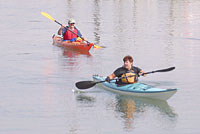
Photo: Robert Barbutti
SEA KAYAKING: Wet Exits
By Deb Bolt
As I make my way down Highway 1 to Monterey, my pulse quickens. I have butterflies, big ones, a mix between dread and exhilaration. I’m sea kayaking for the first time today. I’m heading to Monterey Bay Kayaks for a tour of the bay and introduction to the sport, and tomorrow I will be in Oakland for a beginning sea kayaking class with California Canoe & Kayak.
It is a perfect April day in January. After a few wrong turns, I’m at Monterey Bay Kayaks in Monterey. I join my group, a semi-novice couple from San Francisco, and our instructor Ryan. I sign my life away on a standard release form, and am tossed a paddling jacket and a PFD (personal flotation device), for the adventure. My heart is racing.
I grab some gear and the four of us head down to the water to meet the kayaks. Ryan is the perfect instructor — he’s kind, goes out of his way to make everyone feel safe, has a very calming presence, and knows his stuff.
We put on our gear, learn how to wear the spray skirt, and adjust the multitude of straps on the PFD. I look and feel like a big blue and orange stuffed frog. Ryan shows us the way to hold a right-handed paddle by placing the knuckles of your right hand in line with the right blade, and by placing our arms and paddle above our heads with elbows at a right angle. He says this is the path of least resistance, the best balance between strength and leverage. He demonstrates how to get in the kayak, how to fiddle with the foot pedals, how to deal with the spray skirt, and how to wet exit if we dump. Then we learn a few basic paddle strokes to get us around the shoreline and Monterey Harbor. My apprehension and excitement grows with each new lesson. Then we’re off.
The four of us push our kayaks into the surf and we paddle like crazy past the breaking waves. I’m now wet, thrilled, feeling a little overzealous and can’t wait to hit some huge waves.
Over the next several hours we explore the Monterey Harbor for marine life. Ryan shares the ecology of the area and the names of every bird and animal: grebes, sea lions, cormorants, and pelicans.
As we move into the bigger waves beyond the jetty, Dana starts to get a little freaked. I might be too, if the instructor wasn’t sitting in the back of my kayak. So, we cruise back into the harbor refuge to look for starfish and decorator crabs. Soon, we are land bound.
The next class at California Canoe & Kayak is an immersion program for beginning sea kayakers; there are 6 of us today. The instructor, Mark, is a seasoned kayaker with many years of teaching under his spray skirt, and a few expressions that remind me of Bill Murray. He makes an excellent instructor.
We go through how to wear our gear, how to hold the right-handed paddle, and the basics of a wet exit — and since this all review for me, I’m feeling pretty confident. We practice a few strokes on land, with our assistant instructor, Chris, before entering our single kayaks: the forward and reverse stroke and sweep, and how to use torso rotation to gain the most from our strokes. We learn draw and recovery strokes, and rescues after a lunch break lesson about tides and currents. My eyes glaze over as we review the Bay Area map: I had no idea there are so many swirling tides and currents to consider. Mark is right there with answers to our rookie questions.
The most intense session is the recovery and rescue. The water is freezing. I’m the first one to wet exit, and it’s not on purpose—just that my bracing strokes are lagging behind my enthusiasm. I feel like a wet seal hoisting myself up on the rear deck of the kayak during my paddle-float self rescue, but I pull it off. At this point, my hands are frozen and I’m sitting in the cold water now pooled in my kayak; my bilge pump forgotten on the dock. Luckily, my rescue partner lets me borrow hers, and soon I’m in the water once more for the T-rescue, which involves using the bow of a partner’s kayak to right yourself from your fish-eye view.
We finish up with a relaxing paddle back to Jack London Square in the Oakland Harbor where we began. I’m so happy to have a warm towel, and leave feeling invigorated and enthusiastic about my new sport. I’ll be back next weekend.
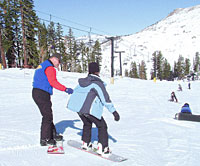
Photo: Christa Fraser
SNOWBOARDING: Snowplowing
By Christa Fraser
When I went skiing as a kid with my grandmother, who was a right ripper in her 50s and 60s, she used to call me a snowplower. To be fair, I was actually quite good at tucking my poles under my armpits, crouching low and heading straight down the hill at what I felt to be warp speed. But that is where my skiing prowess ended. After 20 something years of taking lessons from ski-wee, my grandmother and mom, and a couple of boyfriends who thought they were Glenn Plake’s soul twin, I was still a mediocre, intermediate skier.
For several years, I had been eyeballing snowboarding as a logical next step. With a snowboard, there would be no ski tips to get tangled when plowing into the lift line, my legs wouldn’t head in separate directions when I couldn’t complete a carve, and best of all, I wouldn’t have to carry two sticks and two poles while walking in stiff boots to get a hot chocolate.
So I headed to Bear Valley Ski Resort for my inaugural lesson, accompanied by my boyfriend, Matt, and his 10-year old son, Caleb, who were there to offer me moral support. But as soon as we got to the resort, they ditched me for some blue-diamond warm-ups. That was fine — I was due for my first lesson, anyway.
At the rental department, I got suited up: boots, helmet, wrist guards, and a board set for my goofy-footed stance. Then, I was off to my lesson with six other neo-boarders, and two instructors.
I admit that I’m prone to get a big head with very minor victories. But like many middle of the pack athletes, it becomes deflated just as easily. The first few minutes of my lesson, I felt like the overweight, out-of-shape writer I’d become. My feet were cramping, I was huffing and my legs felt like rubber. We hadn’t even attempted a hill yet.
After a few warm ups and some basic instruction, I gained a measure of comfort. We hit the lift, sweetly named Cub Chair. I, however, renamed it Cuss Chair, because that is what I did after every attempt to exit the chair upright (Once, I wiped out so solidly, that for a second I had the wind knocked out of me). Our lesson at the top of the bunny slope started with all of us wiping out and taking breathers on our butts or knees before trying to get back up. It was a harbinger of things to come: I would venture to guess that none of us went more than 40 feet without a crash. On the upside, the wipeouts never seemed to be painful.
Halfway down the run, I was able to sort of trace the falling-leaf pattern that our instructor demonstrated. In this drill, we basically pointed our bodies, boards, head and hands in the direction we wanted to go and then switched to the other side. This should not be confused with actually turning a board, however. I was getting good. Someone even said, “Hey. Why are you even taking a lesson? You don’t need one.” I smiled knowingly, and then went down in a spectacular heap. By the time we reached the bottom of the hill, our first lesson was over. We had managed to complete one bunny slope run in an hour and a half.
After lunch, I came back with Caleb for a second lesson. Caleb is also a rookie snowboarder and decided to join me for more bunny slope basics. Our instructor, Asa, was wonderful. After showing him what a good base I had developed with the falling leaf, he decided I was ready to learn some turns.
True to my past, however, I simply transferred my snowplowing abilities from skiing to snowboarding. I just kept my front edge up, and scraped snow all the way down. I simply could not psyche myself up to turn. When I tried, I crashed instantaneously. Asa stuck with me, however. Though I didn’t quite get the hang of turning, Asa did help me figure out how to get off the lift upright. Having an instructor can save a rookie a lot of time reinventing the basics.
Quickly, that lesson was also over. Caleb and I were on our own for a couple more tired runs. I was ready to come back another day, for another lesson. I was sad that I hadn’t become a ripper in one day, but I really did enjoy myself. Caleb agreed with me that I had a long way to go. But then, with a 10-year old’s honesty, assured me that I really wasn’t that bad, at least for a grown up. I will be sure to pass that on to my grandmother.

Photo: West World Images
TELEMARK SKIING: Free-heeled Patience
By Cathy Claesson
”Why in the world would you want to learn how to telemark?” my husband asks with a mixture of humor and disdain. Before I get to answer, he continues, “Is tele-skiing sort of inefficient? Isn’t it sort of like doing squats all the way down the mountain? Why not just stick with good old fixed-heel skiing and snowboarding? Is it necessary to purposely make life more difficult?”
At the time, I didn’t have an immediate answer for my husband’s perfectly reasonable questions. Fortunately, I was already committed to taking a tele-ski lesson. I had watched graceful tele-skiers scribing beautiful arcs down the mountainside as a child, and I was still intrigued after all these years. For better or worse, I was going to tele-ski.
A few weeks later, I was heading up to Bear Valley to take my first telemark lesson with Mountain Adventure Seminars. I was happy to be heading up to the snow with a good friend and to have some “girl time.” During the drive up Highway 4 we rocked out to various CD’s and got fired-up to play in the snow.
I pulled in to Bear Valley Cross-Country Center to rent my tele-gear. All of a sudden I was nervous. I had the sneaking suspicion I was about to get my butt kicked. I even considered skipping the class and just snowboarding
all day. That way I would be guaranteed to have fun. But before I knew it, the helpful people at Bear Valley Cross Country had my tele-skis, boots and poles ready to go.
Before long, I was heading up the lift with my MAS instructor, Marty. Still nervous, I was looking at the snowboarders making smooth turns and thinking to myself, “I’d be guaranteed to have fun if I was carving down the mountain on my snowboard.”
Marty distracted my thoughts by speaking of his passion for telemarking and how it opens the backcountry up to skiers. He went on to explain that the adaptability of tele equipment gives skiers the liberating ability to experience the whole mountain.
As we neared the end of the lift, I nervously asked Marty how I’d get off the lift. He said I could ride the tele skis just like alpine skis, as long as I made a conscious effort to keep my heels down. I slid off the lift, kept my heels down and rode down the slope. I instantly knew that my 14 years of alpine skiing would pay off. It was a huge relief and the excitement was building.
Marty skied on ahead of me for my first drill. As I watched him make graceful tele turns, I remembered why I had wanted to try this sport in the first place. I’ve always thought tele skiers look more tuned in to their turns while making their way down the mountain. The tele turn has more elements to it than alpine skiing or snowboarding, and comes together in a rhythmic and graceful dance. No two turns are exactly the same. I was excited by the prospect of linking my own turns together.
The majority of the lesson involved doing drills to practice the four basics of tele skiing — balance, edging, pressure and rotation. I felt a little silly doing some of the drills, but as I began to improve I was encouraged. Too soon, my private lesson was over. Marty left me with what was called the “patience turn,” a turn that starts in a basic alpine turn and once the skis are passed down the fall line would end in a tele turn. This would become the foundation for complete tele turns in the future.
At the bottom of the run and the end of the lesson, Marty had given me enough of a foundation to keep me going through the rest of the afternoon. I abandoned my original plan of grabbing my snowboard for “guaranteed fun down the hill.” I was having just as much fun trying to put my turns together. I spent the rest of the afternoon doing patience turns and by the end of the day was actually linking some regular tele turns together. It was a great end to a fun day of learning something new.
To answer my husband: Tele skiing doesn’t add unnecessary difficulty, but it does make for an interesting and exciting new challenge. One that eventually rewards with increased versatility and a unique, graceful dance with gravity.

Photo: Nadav Aharonov
ROCK CLIMBING: Playing at the Edge
By Dan Curtis-Cummins
As we approached the edge of California Cliff at beautiful Castle Rock State Park before my introductory climbing lesson, I could sense what propels people to rock climb: a love of the natural environment and the “camaraderie” of the sport. On the 15-minute hike from the parking lot to the 55-foot cliff, Benji Weizel, my guide from Outback Adventures, and I talked about the sport of climbing. His enthusiasm for
the sport was contagious.
Benji prepared the class for the climbing lesson. Sarob, Angela, Nadav and I were beginners. For us, this was an experience of trying something new, feeling the instantaneous camaraderie that arises from trusting strangers
with our lives (as Nadav brought to my attention while I was his belayer), and daring ourselves to reach new heights of adrenaline-pumping, seemingly extreme adventure.
For Benji, it was just one of numerous trips he makes to the cliffs to teach various levels of rock climbing. Castle Rock offers a perfect climbing classroom, with easier, beginner routes that are rated 5.7, like California Cliff, to others rated in the mid 5s (on the American climbing scale of 5.5-5.15) like at Indian Rock or Summit Rock.
Our lesson for the day would be on the basics of free climbing. Free climbing involves many technical skills that range from tying the proper knot (a figure-8 followed with a double fisherman’s knot), to tightening your harness correctly, to learning the skills of smooth belaying.
The rope we used was an 11 mm thick, 70-meter ‘dynamic’ rope, made of strong, elastic material for better absorption of falls. The belayer holds the other end of the climber’s rope, attached to his/her harness through carabiners and the belay device. The belayer watches the climber intently and works to “pull, grab, slip, and break” the rope, essentially eliminating slack and cinching the rope in the belay device, repeating the cycle as the climber ascends.
When we were ready to descend, our belayer steadily released the rope and lowered us down. The most exhilarating point of my day was during my first climb, after I had sought out all the holds and gathered the strength to reach the peak of the 45-foot face. From below Benji told me to let go of the rock. This felt like a totally unnatural move, but, defying my intuition, I followed his instruction: “sit” in your harness, trust the rope, and bounce down the rock with your feet. We developed a strong respect for the rope; if we stepped on it at any time, Benji said we had to kiss it to show our appreciation for being our “lifeline.”
Throughout the day, Benji stressed that “communication is the most important thing,” especially between the climber and belayer. We learned to check each other’s gear before each climb, and ask, “Is my belay on?” “Belay’s on.” “OK, I’m climbing.” “Climb on.” When I traversed side to side and needed more rope, I would ask my belayer for “slack,” or if I needed the rope tighter, I would say “up rope.”
After lunch, we all got a chance to try “chimney climbing” in a large crack. It requires a different climbing technique called “stemming,” using the heel of one foot and toe of the other, as well as your back and shoulders, to wedge between the rocks, gradually pushing and pulling yourself to the top. Chimneying was a challenge, but the technique demonstrated to us that climbing involves many different skills and that route options evolve from these varying skills.
California offers a bounty of famous and lesser known areas to enjoy climbing. Benji noted that the terrain and weather conditions of California can spoil beginning climbers, with many nearby and varied locales such as Castle Rock, Mt. Diablo, the Pinnacles near Hollister, Indian Rock in Berkeley, Tahoe and Yosemite.
Benji, a self-taught climber who began climbing at 16 in Minnesota, was a thorough and knowledgeable guide who made our first experiences on the rock relatively easy. We felt well-informed and very safe with his instruction. Not to mention excited to come back for another lesson.
KITESURFING: On the Clock
By David Solomon
As I pulled into the east entrance of Crissy Field in San Francisco, a rush of excitement came over me. Here I was, at the beach where I had spent so many hours hypnotized watching an intriguing new sport; a sport that I had almost subconsciously developed a desire to learn. Waiting for my instructor, I daydreamed of speeding through the bay as I jumped, spun and slashed on the water.
Kitesurfing strikes me as the perfect synergy of water boardsports, combining the mentality of surfing with the endurance of wakeboarding and the freedom of windsurfing. Needless to say, I was eager to start.
Cruising through the parking lot, however, I began to get the creeping suspicion that all was not right. Shaking off my reverie, it registered that the beach and its waters were totally empty of kitesurfers and windsurfers. I half expected tumbleweeds rolling along the beach. It was a desolate scene and there was not enough wind to even jostle a flag. Crissy Field was calmer than I had ever seen it before and I quickly realized that conditions were not ideal for my first kitesurfing experience.
Optimistic nonetheless, I met my instructor Rebecca Geffert, who teaches both wind and kitesurfing at Boardsport’s school in Alameda. She immediately commented on the lack of wind, but gave me hope, saying that it could still pick up.
As we walked to the launching area, Rebecca wasted no time in explaining the requisite knowledge that any would-be kiter needs to know. Patiently, she covered everything from jargon to theory. I found it interesting, if not totally foreign. I had to switch my thinking into the nautical mode where all directions are dictated by the will of the wind. There was no backwards or forwards, just upwind and downwind. There wasn’t an up, down, left, or right; there was a 3 o’clock, 9 o’clock, and 12 o’clock. And there were two clocks to consider: the vertical position of the kite and the horizontal direction of the rider.
After I had grasped the directional concepts and understood the importance of relating everything to the wind direction, Rebecca stepped it up a notch and started to explain the mechanics of the kite to me. She made it clear that kite control and safety are 80 percent of the sport, while board riding is only about 20 percent. Soon, I had a handle on where the kite’s “power zone” was, how to steer it and how to determine who has right of way. Just as it seemed we had reached the limits of the oral lesson, the wind began to pick up.
Rebecca sprang into action. Quickly taking out the tiny trainer kite that all novices begin on, she prepared it for flight as I stood by, excited to make my first foray into the sport that I had wanted to learn for so long. With a small toss, the kite shot up into the air. Rebecca maneuvered it in large swooping figure eights, while explaining proper kite position and steering technique. I was chomping at the bit to try it myself, and sensing this Rebecca relinquished the miniature kite. Despite my initial clumsiness, I found the kite somewhat forgiving in its willingness to stay aloft and respond to my rookie skills. But it turned out to be tougher than it looked, and the little kite sustained several crushing nosedives. I experienced some strong resistance when the wind got cranking, or so I thought. Rebecca said the breeze was too mild to really get a feel for the kite’s power.
With wind and the lesson winding down, Rebecca explained that at least six hours time on the training kite was prerequisite to taking out a full size kite. After that, she said that there was quite a bit of time spent on land mastering the larger kite before one even ventured into the water, and eventually began to be towed on a board. Undaunted by the commitment, I promised Rebecca that when conditions permitted, I would be back.

